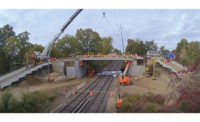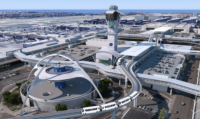
From cold-ironing at port harbors and beehive programs at airports to porous pavements, recycled asphalt aggregate and "green roads" rating systems, the transportation industry's efforts to address climate change have been growing over the last decade. But Hurricane Katrina in 2005 and the devastation of Superstorm Sandy last fall have increased the sense of urgency about responding to severe weather events and building more sustainable facilities.
At one of many sessions on transportation and climate change this January, U.S. Government Accountability Office staffers told attendees of the Transportation Research Board's annual meeting that Louisiana transportation officials designed a new Interstate 10 bridge with the help of wave-mechanics experts' storm scenarios. As a result, the new twin-span bridge is 21 ft higher and has rigid concrete-deck connections, high-performance concrete girders and open railings to reduce wave forces. The new bridge proved more resilient against Hurricane Isaac in 2012, said Anne Hobson, senior policy analyst with the GAO. But GAO's study, which also included state Route 522 in Washington state and Highway 1 in Louisiana, found that "climate change has not been systematically considered in infrastructure planning," she added.
Groups such as the Green Highways Partnership (GHP) continue to push for that consideration. Eleven years ago, the U.S. Environmental Protection Agency formed GHP with some federal highway counterparts, state transportation agencies and private firms. It has since sponsored various training events with the American Society of Civil Engineers, the National Ready-Mix Concrete Association and others.
A report by the U.S. DOT's Center for Climate Change and Environmental Forecasting and the U.S. Geological Survey (USGS) that focuses on Mobile, Ala., is scheduled for completion this year. Its aim is to provide replicative methods and tools that address potential impacts. "We have [in Mobile] a major port, rail, airports, Interstates, tunnels and a major downtown on the river," says Kevin Harrison, director of transportation planning, South Alabama Regional Planning Commission. "It comes down to climate adaptation and education on what that is."




Post a comment to this article
Report Abusive Comment